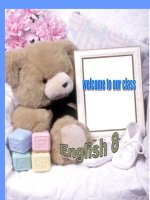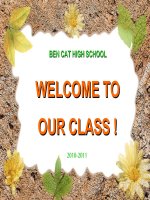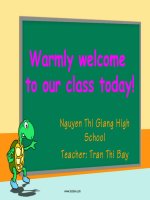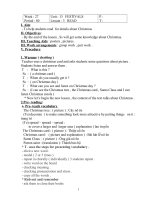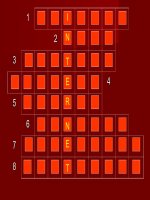SKKN TIẾNG ANH: Integrating environmental education in English through Unit 6 read in Tieng Anh 9.
Bạn đang xem bản rút gọn của tài liệu. Xem và tải ngay bản đầy đủ của tài liệu tại đây (2.99 MB, 21 trang )
Teaching experiment
PART I: INTRODUCTION
All the knowledge in life to be associated with each other. The subjects at school
are different, but always be associated, complementary.
Therefore, teaching towards integrating is the advanced, modern teaching trend
that some teachers have done in practice. Specially, English - a subject can
integrate more knowledge of other subjects.
When construction of individual lessons in subjects in English class, the teacher
will easily see the content of this lesson related to the knowledge from which to
build towards integrated lesson plans, exploration, and development extensive
knowledge in other subjects. With lessons have content related to landmarks like
Unit 11 Traveling around Viet Nam in grades 8, teachers can exploit the
geographical position, climate, human characteristics, flora and fauna ... of Nha
Trang, Da Lat , Ha Long and Sa Pa ... as geography or biology. The students will
enjoy participating in learning activities for all sites on the popular tourist spot that
someone could have ever been to or seen much on TV. The lesson of architectural
culture, history as Unit 14 Wonders of the World (also in Grade 8), teachers can
integrate into that knowledge of history, geography or art. The work was built by
whom? where? of which country? geographic location like? ... Or that work related events, historical figures? or its highlights the beauty of architecture, art
worthy to be remembered? ... Lessons related to the environment such as Unit 16
Man and the environment (in grade 6), Unit 10 Recycling (In grade 8), Unit 6 The
environment (in grade 9), teachers are able to integrate knowledge from disciplines
geography, biology or civic education by giving students learn about
environmental concepts? The current environmental situation in Vietnam? In your
area? How polluted is it? What should you do to protect the environment, reduce
pollution? some actions you have done?
When teaching English, teachers can be able to integrate knowledge from different
subjects and when such integration, lessons will be lively, to attract more students.
Since then students will actively study when presented his insights in other areas,
other subjects in English class. To present fluent knowledge of other subjects and
knowledge from reality, they should try to learn vocabulary; grammar can express
well, and so that they are actively learning, learn English a stimulating and active.
To catch up with new trends as well as recognizing the potential of students, I
installed several integrated lessons to help them receive lessons interesting and
more confident when using the language expressing their knowledge. So I choose
School year: 2017 – 2018
Page 1
Teaching experiment
the topic: "Integrating environmental education in English through Unit 6 read
in Tieng Anh 9".
Through this writing, I want to create excitement for the children to study and to
understand the importance of the environment. So they will take the right actions
to help protect the environment.
PART II: IMPLEMENTATION
1. Theoretical backgrounds.
Environmental protection is one of many concerns globally. In our country,
protecting the environment is also a matter of deep concern.
Decision No. 1363 / QD- TTg of October 17, 2001 by the Prime Minister on
approving the project: "Bringing the contents of environmental protection in the
national education system" and Decision No. 256/2003 / QD - TTg dated 02 to 12
years 2003cua Prime Minister on approving the strategy of national environmental
protection until 2010 and orientations towards 2020 have created a solid legal basis
for the effort and determination environmental protection -oriented development of
a sustainable future of the country.
Specifying and implementing the policy of the Party and the State, January 31 st
2005, the Minister of Education and Training has issued directives to strengthen
environmental protection education, determination key tasks for 2010 and
subsequent years for general education is to equip students with the knowledge and
skills about the environment and environmental protection in the form of matching
in the subject and through activities extracurricular activities, modeling green –
clean - beauty school matching regions.
2. Practical backgrounds.
a. About water resources:
Population growth and increased economic activity and task management of water
resources are not well made in Vietnam are being overuse and pollution.
School year: 2017 – 2018
Page 2
Teaching experiment
Pollution of water resources in HaNam
In recent times, in Vietnam took place water scarcity. Central parts of the state
have expressed desertification, coastal areas salinisation and salinisation. In the
central region, the Central Highlands, Southeast and other areas has occurred
tension of water. Cities like Hanoi, Ho Chi Minh City, Hai Phong, Bien Hoa ...
contaminated water to a critical level. Environment water in some rivers such as
River Bridge (in Tonkin), Thi Vai River, Saigon River, Vam Co Dong river (in the
Southeast) were heavily contaminated. Freshwater resources for production and
daily life of people is increasingly diminishing. Not only in Vietnam but also
worldwide shortage of fresh water also become a serious problem .
Lack of fresh water
b. About forest resource:
Forests are valuable resources of our country. Forests as climate regulation, soil
protection, water retention and groundwater is a repository of valuable genetic
resources. However, the forest cover of the country in the long term downward
trend, many forests are seriously damaged, making the ecological environment is
reversed, the habitat of the animals shrunk, endangered rare animals ...
School year: 2017 – 2018
Page 3
Teaching experiment
Indiscriminate deforestation
c. About the air
In Vietnam, the air pollution is a pressing problem for the urban environment,
industrial and handicraft villages.
Vietnam is among 10 countries with the most polluted air in the world, according to
an annual study of the environment by the US universities perform and announced at
the World Economic Forum in Davos recently.
Air
pollution caused by dust in Hanoi
Cement factory dust in Anh Son white painting of sky
School year: 2017 – 2018
Page 4
Teaching experiment
d. About garbage:
Along with the development of the economy and life growing up, the amount of
waste is also increasingly more. The increase in population, urbanization situation
quickly has increased the amount of waste.
Huge amounts of waste daily in big cities
Besides the environmental reality of national stature, then in locally where they live
environment issues are also coming to an alarm. Especially in the populated areas
through as the marketplace, trench, sewer ... Despite sanitation teams regularly
cleaned but because people are not aware of self to the community, clean indoor but
not be interested in the streets.
Garbage everywhere
Also infrastructure did not meet the requirements, as well as a garbage dump where
garbage processing technique does not ensure pollution caused phenomenon.
School year: 2017 – 2018
Page 5
Teaching experiment
Over 5 ha landfills are likely to cause pollution of drinking water for the inhabitants of the Quynh Tan,
Quynh Luu district.
Even in school, although thoroughly, regular reminders of school administrators as
well as the total charge of the daily and labor department are assigned alternately
class, direct labor to clean up. But not so self conscious of some students to stay in
school grounds, corridors and school building as well as in the classroom still see the
arrival of the garbage.
Students littering
3. Solution and implementation:
Today, life is growing increasingly modern, materialistic life and spirit of the
people increasingly improved, however, opposed to it, environmental pollution has
complex developments. Environmental pollution is a serious problem not only for
School year: 2017 – 2018
Page 6
Teaching experiment
a certain region, but everywhere, both rural and urban, mountainous and coastal
region, both the water and the air ...
To overcome the consequences on the need for a long time, continuity, now and
costs a lot of effort and money. Consequently, environmental protection should
begin by educating the sense of environmental protection, especially for pupils and
students. Currently, education awareness, equipped with knowledge about
environmental protection in schools is not focused properly, environmental
protection has not been considered as a subject at the high school level, except
some universities and colleges have specialized courses on the environment. This
Division has only been integrated in biology, civics, geography and some
extracurricular lessons. Some environmental contest was held in the school, in
general, are still largely formal. Therefore, awareness of environmental protection
so clearly not formed in school classes and students.
For the education of environmental awareness in schools is effective, when the
education of environmental protection can not be a class, they need to educate
students starting in the job, the smallest actions planting and care of trees; Hygiene
schools; organizes environmental forum for students to participate in a democratic
manner; educate students consciously save energy such as electricity and water,
encourage students with innovative ideas recycling ...
In the process of composing lectures, teacher meticulously thorough preparation of
visual aids and activities on how to stimulate the dynamism, interest in learning in
students. Also encouragement the children involved in the process of preparing all
the scrap using at home, at school they collected to create useful items.
3.1. Procedures:
Step 1. Select Unit 6: Lesson 4: Read in Tieng Anh 9 to study.
Step 2. Design or collect a selection of pictures/ teaching aids that we could use to
present our lesson.
Step 3. Write a lesson plan for that unit.
Step 4. Teach a lesson and takes notes on how it is carried out.
Step 5. Evaluate of the effectiveness of our lesson.
Step 6. Write a report about our teaching experience.
3.2. Data analysis
Analyze: Unit 6: Lesson 4: Read in Tieng Anh 9
This is a poem written about the environment. This topic is very high educational in
school, but rarely transmit because poetic language is very confusing. The poem
talks about outing of the mother and child. He was asking her mother what would
happen if the environment is polluted. His mother replied that everything will
School year: 2017 – 2018
Page 7
Teaching experiment
become very bad, the world would like a waste, any treasure would disappear, the
field will be filled with garbage, the river will be the white foam dong. ... That
means mothers explained to him the harmful effects of environmental pollutants. It
did not make sense. Reading this we seem to think that the sense of the good mother.
But no, after he explained about the harmful effects of environmental pollutants, the
mother told the boy to throw the grass drinking soda over the fence just to help to
bring home. After hearing the boy seemed to disagree, not only child support, the
mother also tells the boy is silly because only other people pollute the environment
are the only mother he just throw a few cans of soda are not saturate anywhere. Your
mother can not fault him at all, they are just trying to enjoy their holidays only.
3.3. Teach the lesson and take notes on how it is carried out.
Before presenting the lesson, I asked students to prepare the lesson in goups. Each
group will made me some products made from garbage to show in front of the
class. This will help students to feel more interesting and more united in
understanding the lessons together. Then I taught this lesson for 120 students in
our school. And I followed the lesson plan I had made and carried out all the
things I prepared with my students.
I organized the following activities:
Activity 1: The reading skill was taught in this lesson, a poem about environment,
so before reading I improve a video about environmental problem in city, let
students watch and answer some easy questions to find the message from it in order
to lead them to the topir of the reading task.
School year: 2017 – 2018
Page 8
Teaching experiment
Some photos from video
Activity 2: Teaching vocabularies: To help students understand the passage easily,
I provided some new words by using pictures and synonyms before they practiced
reading for detail.
School year: 2017 – 2018
Page 9
Teaching experiment
School year: 2017 – 2018
Page 10
Teaching experiment
Activity 3: Matching: In order to check vocabulary understanding and save the time
I choose task 1(p.51) in text book in this activity.
Activity 4: True or False statements.
In order to make students have the first thought about the content of the reading
passages I asked students: “Look at the picture and answer some questions. Is this
place clean or not? Is that polluted or unpolluted?”. I got some quick answers and
then I give them T/F statements to guess more about the reading task. After some
minutes I asked students to give their prediction.
Activity 5: Answer the questions:
To check student’s comprehension we asked them to do task b(p.51) in pairs
“Read the poem about the environment carefully and answer the following
questions. Then write the answers in your exercise books.” While they did, I went
around the class to give the help if necessary and control their working. After that
we checked their answers by letting them play a game “Lucky numbers”. During
this activity, all the students took part in the activity cheerfully and we found that
this is the best way to check the students’ understanding and to motivate students
in learning, especially students can easily give the answers without shyness.
Activity 6: Discussion
We give students this exercise in order to reinforce and consolidate the
information about the environment and to relate the poem with students’
experiences and backgrounds and interest about environmental protection. I asked
them to work in 2 big groups:
Group 1: What could you do in your school to minimize pollution?
Group 2: What could you do in your house to minimize pollution?
While I moved around the class to give the help if necessary. However, I found
that only good students took part in this activity and the bad ones kept quiet or no
more ideas.
Ater a few minutes, I collected their idea by asking the representative to present
infront of the class. Then I gave them a mindmap that I prepared.
School year: 2017 – 2018
Page 11
Teaching experiment
LESSON PLAN
Period 40:
Unit
6:
The
environment
Lesson 4: Read
A) Objectives: By the end of the lesson, students will be able to:
- Understand the poem with some old English by doing matching
exercise and answering questions.
- Know how to protect environment at home, at school, in public
places and know remind their friends commit.
B) Language focus: - Vocabulary: end up, junk-yard, folk, stream, treasure, foam,
hedge.
- Grammar / Structure:
C) Teaching aids: text book, extraboard, pictures, flash cards, tape.
D) Teaching skill: reading
E) Teaching procedure:
Teacher’s activities
Students’ activities
Warm up (5’)
- Asks students:
School year: 2017 – 2018
*) Situation:
- answer
Page 12
Teaching experiment
? Do you like watching film?
? Do you like watching film now?
- Gets students to watch a short film - watch film.
carefully and find out the answer: What
do you think about these people’s
actions?
- Plays video. Then asks:
- answer
? What can you see on this film?
? Is there a garbage bin? Are there any
people?
? Are these people throwing the trush
into the garbage bin?
? Are they doing the right or wrong?
? Should you throw things like that? → Pollution.
Why?
- Leads in: Nowadays, our environment
is polluted. Who polluted it? How do
they polluted it? Today, we’ll read a
poem about environment pollution in
new lesson.
Pre – reading. (12’)
1. New words:
- Teaches vocabulary one by one.
+ picture
+ junk-yard (n): bãi phế thải
+ picture
+ treasure (n): kho báu
+ picture
+ foam (n): bọt
+ synonym “finish”
+ end up (v): kết thúc
+ picture
+ stream (n): dòng suối
+ picture
+ hedge (n): hàng rào
+ synonym “people”
+ folk (n): người (Tiếng Anh cổ)
- Reads the whole words and asks - Read after teacher.
students to follow.
- Calls on some students to read.
*) Checking vocabulary: “Matching”
- Corrects students’ mistakes.
2. Matching:
- match
School year: 2017 – 2018
Page 13
Teaching experiment
- Asks students to close their notebooks *) Answer keys:
and do matching (p. 51).
1–c
2–g
5–d
6–a
- Corrects and gives the keys.
3–f
7–b
- Sets the scene: Shows the picture on - Look at and answer.
screen:
? Who are they?
? Where are they?
? Are they having a picnic?
? Is this place clean or not?
? Is that polluted or unpolluted?
- “So what do they think about pollution?
They think the same or different. We will
read the following funny poem to know.
Before reading, I would like you to do T/
F prediction”
3. True or False:
a. The world will end up like junk-yard *) T/F prediction:
- predict
if the pollution goes on.
b. The fields will be clean with plastics
and tins.
c. The streams will not be covered with
foam.
d. The mother thinks she and her son
pollutes the environment.
While – reading (13’)
*) Checking prediction:
- Read and check.
- Lets students read the poem and check
their prediction.
4. Answer the quetions:
- Asks students to correct false sentences. - Work in pairs.
- Corrects.
- Play game in group.
- Asks students to read the poem again,
School year: 2017 – 2018
Page 14
4–e
Teaching experiment
work in pairs to ask and answer the
questions (p.51)
- Gets students to answers by playing
game: “LUCKY NUMBER”
1. According to the mother, what
will happen if the pollution goes
on?
2. Lucky number
3. Who does the mother think
pollute the environment?
4. “Do you think the boy’s question
(line 9-10) is silly? Why?
*) Answer keys:
5. Lucky number.
1. If the pollution goes on, the
6. What will happen to the boy if he
world will end up like a second
keeps on asking his mother such
hand junk-yard.
questions?
3. The mother thinks other people
7. Does the poet want us to learn
pollute the environment but not
that everyone is responsible for
her and her son
stopping pollution?
4. If the boy keeps on asking such
8. Lucky number.
questions, his mother will take
- Corrects.
him home right away.
- Praises the winner and gives the keys.
6. No, because he is right: if he
throws the bottles that will be
polluting the woods.
7. The poet wants us to learn that
everyone is responsible for
keeping the environment from
pollution.
Post – reading (12’)
5. Discussion:
- Asks students some questions:
? Is the mother right when she tell her - answer.
son to throw the bottle over the hedge?
Why? (Will it pollute the environment?)
? What about you? Should you throw
everything on your school yard?
? Is your school clean or not?
- Work in groups.
? Do you want to make it cleaner?
- Lets students work in 2 big groups and
School year: 2017 – 2018
Page 15
Teaching experiment
discuss:
*) Possible answers:
G1: What could you do in your school to
minimize pollution?
G3: What could you do in your house to
minimize pollution?
- Feedback and corrects mistakes.
Consolidation (2’)
- Lets students remind all language that - answer.
they learnt in the poem.
? What can you learn from our lesson to
day?
“Let’s act today for your beautiful life in
the future.”
Homework (1’)
- Asks students to:
- Write exercises
+ Write all the answer in notebook.
+ Learn by heart new words.
+ Prepare for next period (Write – Unit
6)
Handout for the lesson 4: Read
a. The world will end up like junk-yard if the pollution goes on.
b. The fields will be clean with plastics and tins.
c. The streams will not be covered with foam.
d. The mother thinks she and her son pollutes the environment.
Students’ products
School year: 2017 – 2018
Page 16
Teaching experiment
Students took part in outside activities to help protecting environment
School year: 2017 – 2018
Page 17
Teaching experiment
Some products from garbages which students made after the lesson
School year: 2017 – 2018
Page 18
Teaching experiment
Part III- CONCLUSION
1. Each unit is a teacher’s construction so before making any public lessons,
teachers also need to put the research to find out which direction to suit each
learning object. Especially, with the lessons of actual contact form and integrated,
teachers must prepare meticulously for practical educational activities and
appropriate educational lessons and apply high.
2. Teachers should choose words and basic structure, understandable to guide
students. This determines success to lessons because if students do not understand
the content or misuse structure, the whole purpose and request the Unit seen as not
met.
3. During the course students work in groups, teachers need to closely monitor
their activities. Thereby, we can more accurately assess the capabilities of each
child through the level comments on the product of the whole group, distinguished
by strong students and poor students. Not only that, teachers also help students in
time when they want to promote their creativity.
Exploiting a lesson how to fit all types and especially with his pupils is essential
for every teacher. Especially integrated lessons. Therefore, my way on this new
well is the initial test and showed realistic, harmonization and feasibility for
different pupils. I think there are ways other operators of this type that I look
forward to additional colleagues, suggestions for us together to design teaching as
required and new methods more effective.
We also are looking forward to consult the research of colleagues to everimproving their teaching skills more.
Thank you very much!
School year: 2017 – 2018
Page 19
Teaching experiment
Reference:
1. Nguyen Van Loi. Tieng Anh 9. NXB Giao duc.
2. Nguyen Van Loi. Sach giao vien Tieng Anh 9. NXB Giao duc
3. Madsen, K.S and J.D Bowen (1978): Adaptation in Language Teaching.
School year: 2017 – 2018
Page 20


